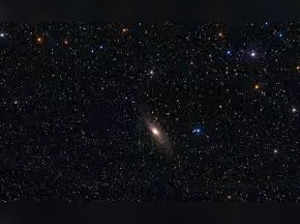 Agencies
AgenciesEveryone loves watching the night sky, as it’s filled with gleaming stars and radiant moon, disseminating light that’s reaching the earth. But there are certain astronomical objects that can’t be easily seen with a naked eye. Telescopes have solved this problem, converting the impossible to possible, and making humans get the ultimate gratification of watching various astronomical events in the sky. There are certain things that we regularly see in the sky like the sun, moon, stars, etc. Do you know how much time it takes for the light to pass through space coming from any of these astronomical objects?
Case-in-point, the Sun is very close to Earth and the time the light takes to reach the Earth surface is 8.3 minutes. Simply put, humans who witness the sun from the earth's surface are 8.3 minutes past from when the sun was originally emitting the light. This aspect goes with almost every celestial object that's revolving in the sky. It means, the light emanated from any celestial body takes a similar time gap to reach the inhabitants on earth.
Now, to know how light exudes earth, you have to know what's a light year? The distance of light coming from the celestial objects is measured by the light year. It's an astronomical metric used to compute the speed and distance of light traveling through space in one year. And the speed of the light traveling through space is 186,300 miles per second.
According to the International Astronomical Union, a light year is nothing but the total distance the light traveled in one Julian year or 365.25 days in vacuum. NASA defined light year as the light cruised in interstellar space at 5.88 trillion miles in one year. Since you know the light speed, let's know how fast it's in miles per hour. But frankly, there's no accurate figure for this, so measuring in such units can't be done.
However, one thing we got to know about light speed is that, the light exudes at 670 million miles per hour or 670,616,629 mph
Case-in-point, the Sun is very close to Earth and the time the light takes to reach the Earth surface is 8.3 minutes. Simply put, humans who witness the sun from the earth's surface are 8.3 minutes past from when the sun was originally emitting the light. This aspect goes with almost every celestial object that's revolving in the sky. It means, the light emanated from any celestial body takes a similar time gap to reach the inhabitants on earth.
Now, to know how light exudes earth, you have to know what's a light year? The distance of light coming from the celestial objects is measured by the light year. It's an astronomical metric used to compute the speed and distance of light traveling through space in one year. And the speed of the light traveling through space is 186,300 miles per second.
According to the International Astronomical Union, a light year is nothing but the total distance the light traveled in one Julian year or 365.25 days in vacuum. NASA defined light year as the light cruised in interstellar space at 5.88 trillion miles in one year. Since you know the light speed, let's know how fast it's in miles per hour. But frankly, there's no accurate figure for this, so measuring in such units can't be done.
However, one thing we got to know about light speed is that, the light exudes at 670 million miles per hour or 670,616,629 mph
FAQs:
- What is a light year?
Light year is nothing but an astronomical metric used to compute the speed and distance of light traveling through space in one year. - What’s the distance of 1 light-year in Earth years?
Generally, the speed of the light traveling through space is 186,300 miles per second. The number of seconds per day is 86,400. And the number of days in a year is 365. So, the distance of 1 light-year in Earth years is 186300×86400×365≈5,875,000,000,000 miles.
Disclaimer Statement: This content is authored by an external agency. The views expressed here are that of the respective authors/ entities and do not represent the views of Economic Times (ET). ET does not guarantee, vouch for or endorse any of its contents nor is responsible for them in any manner whatsoever. Please take all steps necessary to ascertain that any information and content provided is correct, updated, and verified. ET hereby disclaims any and all warranties, express or implied, relating to the report and any content therein.
Read More News on
(Catch all the US News, UK News, Canada News, International Breaking News Events, and Latest News Updates on The Economic Times.)
Download The Economic Times News App to get Daily International News Updates.
Read More News on
(Catch all the US News, UK News, Canada News, International Breaking News Events, and Latest News Updates on The Economic Times.)
Download The Economic Times News App to get Daily International News Updates.





